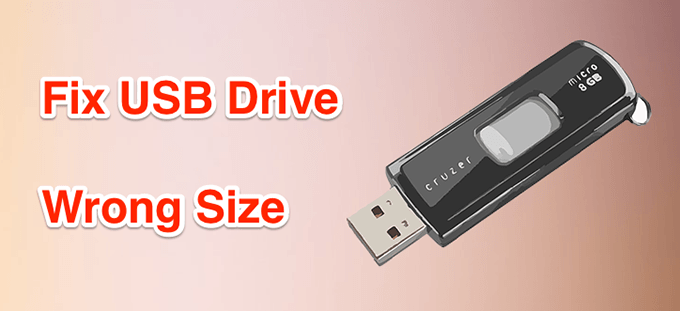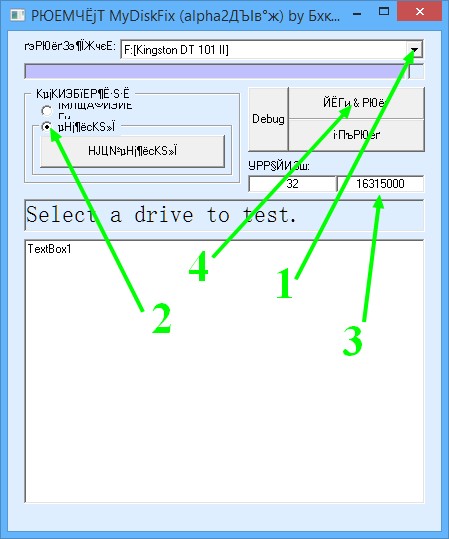I was given a fake 2 TB pendrive (with the "Samsung" label in it) and while Windows 10 64-bit says it has 1.9 TB free and it's using exFAT, I did some research and noticed some programs can reveal the actual smaller size and perhaps this is fixed by you readjusting the partition size to fit what is real and not false information.
The problem is that I have no idea which programs can do each task. Here's a summary of what I need:
1) To know the actual true size of this flash drive. With 100% certainty.
2) To adjust this pendrive to only use what it can hold. I also want to know if it's true these fake pendrives ALWAYS corrupt the files (or some of them) you put there, even if you only use less than what they can hold. I read one guy saying it corrupt ALL the files.
Here's what I tried so far:

 helpdeskgeek.com
helpdeskgeek.com
***
Fix An Incorrect Size USB Drive Using Command Prompt
The wrong USB drive size issue can be fixed using Command Prompt as well. There’s a command that allows you to remove all the partitions, format your drive, and then re-create partitions on the drive.
Open the Start Menu, search for Command Prompt, right-click on it when you see it in the results, and select Run as administrator.
(It says for me to use DISKPART):
The problem is that if I do this command:
format fs=fat32 quick
The pendrive does not accept it, and worse: it becomes invisible to Windows, but visible to these software that can detect it. In other words it rejects a FAT32 format and forces you to always use exFAT in this final step.
***
Another program in which it happens the same thing:
BOOTICE
- Resolve The USB Drive Wrong Capacity Issue With Bootice (read the HelpDesk link)
****
Then I tried H2TESTW:
Problem is that "VERIFY" option is greyed out (not available), only write + verify. If we try this one it will (if I am not mistaken) take more than 2 days to complete this task. I have no idea if it will take 1, 2 hours (so much less) once it reaches, say, 32 GB.
Another program that I was told to use was AIDA64:
https://www.aida64.co.uk/pendrive
If I put the biggest block size it will end the checking after a while. In the first attempt it said for RANDOM WRITE + VERIFY with a blocking size of 2 MB (insted of 64 KB):
DATA INTEGRITY ERROR AT 140 GB. TEST STOPPED.
Then I tried with the same 2 MB. Again the same config, but look at the new result (after a few seconds):
DATA INTEGRITY ERROR AT 1352 GB. TEST STOPPED.
Now let's look what happen if we use a 8 MB block size:
DATA INTEGRITY ERROR AT 205 GB. TEST STOPPED.
Suffice to say this test isn't saying anything.
AIDA64's website tells us:
The method Linear test + Verify is the most thorough, but it also takes a long time. To speed up the process, select Random Write + Verify, which will try to write data to random memory cells. This way we will see in a few seconds if there are issues with our device. If we type a block size bigger than the default value in Options / Block size, we can further boost the speed.
****
How much time? 55 hours again?
So I repeat these two questions:
1) What's the quickest and most accurate way of knowing the true size of this fake 2 TB pendrive (and what software);
2) How can I adjust this thing to only use the max size it can hold?
If I can't solve 1) and 2) I am going to throw this thing away or give to someone else.
The problem is that I have no idea which programs can do each task. Here's a summary of what I need:
1) To know the actual true size of this flash drive. With 100% certainty.
2) To adjust this pendrive to only use what it can hold. I also want to know if it's true these fake pendrives ALWAYS corrupt the files (or some of them) you put there, even if you only use less than what they can hold. I read one guy saying it corrupt ALL the files.
Here's what I tried so far:

How To Fix USB Drive Showing Wrong Size
If your USB drive is shown with a wrong size on your computer, it’s likely the result of an improper formatting of the drive. Instead of seeing the actual 16GB or whatever the size of your USB drive is, you’ll see something like a couple hundred MBs available on it. When you see that, don’t
***
Fix An Incorrect Size USB Drive Using Command Prompt
The wrong USB drive size issue can be fixed using Command Prompt as well. There’s a command that allows you to remove all the partitions, format your drive, and then re-create partitions on the drive.
Open the Start Menu, search for Command Prompt, right-click on it when you see it in the results, and select Run as administrator.
(It says for me to use DISKPART):
The problem is that if I do this command:
format fs=fat32 quick
The pendrive does not accept it, and worse: it becomes invisible to Windows, but visible to these software that can detect it. In other words it rejects a FAT32 format and forces you to always use exFAT in this final step.
***
Another program in which it happens the same thing:
BOOTICE
- Resolve The USB Drive Wrong Capacity Issue With Bootice (read the HelpDesk link)
****
Then I tried H2TESTW:
Problem is that "VERIFY" option is greyed out (not available), only write + verify. If we try this one it will (if I am not mistaken) take more than 2 days to complete this task. I have no idea if it will take 1, 2 hours (so much less) once it reaches, say, 32 GB.
Another program that I was told to use was AIDA64:
https://www.aida64.co.uk/pendrive
If I put the biggest block size it will end the checking after a while. In the first attempt it said for RANDOM WRITE + VERIFY with a blocking size of 2 MB (insted of 64 KB):
DATA INTEGRITY ERROR AT 140 GB. TEST STOPPED.
Then I tried with the same 2 MB. Again the same config, but look at the new result (after a few seconds):
DATA INTEGRITY ERROR AT 1352 GB. TEST STOPPED.
Now let's look what happen if we use a 8 MB block size:
DATA INTEGRITY ERROR AT 205 GB. TEST STOPPED.
Suffice to say this test isn't saying anything.
AIDA64's website tells us:
The method Linear test + Verify is the most thorough, but it also takes a long time. To speed up the process, select Random Write + Verify, which will try to write data to random memory cells. This way we will see in a few seconds if there are issues with our device. If we type a block size bigger than the default value in Options / Block size, we can further boost the speed.
****
How much time? 55 hours again?
So I repeat these two questions:
1) What's the quickest and most accurate way of knowing the true size of this fake 2 TB pendrive (and what software);
2) How can I adjust this thing to only use the max size it can hold?
If I can't solve 1) and 2) I am going to throw this thing away or give to someone else.



